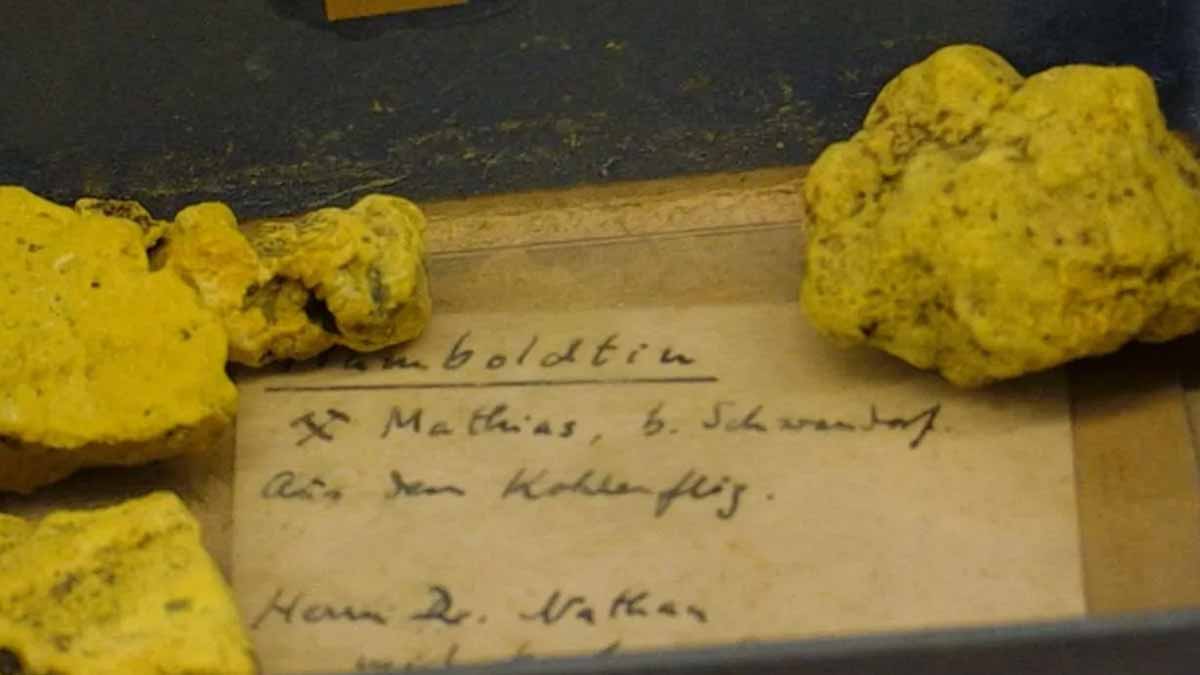An old envelope resurfaces after decades, and a quiet shelf suddenly matters. Curators follow a vague note, then a shoebox yields bright fragments that shift a scientific story. Tests confirm a member of the rarest minerals, and a forgotten mine gains new life in the lab. Because each clue fits the next, a single label opens doors to knowledge, technology, and a fresh respect for meticulous archives.
A 1949 clue points to a hidden trove of rarest minerals
The trail begins with a 1949 letter, found in 2023 during a digitization effort in Bavaria. Archivists in Hof read the line “Humboldtine from the Mathias mine near Schwandorf,” then alert geologists. Roland Eichhorn’s team searches more than 130,000 catalogued pieces under the agency’s headquarters. A small box appears, holding lemon-yellow, hazelnut-sized nodules and a handwritten label that matches the note.
The chain of custody looks sound, so the team moves carefully. Because provenance can mislead, they recheck every detail, from ink and paper to storage history. Each control reduces doubt while momentum grows. The nodules match the location, tone, and texture described in the letter. A find that started with dust now has weight, shape, and context. A private message, once lost, becomes a public key, and a quiet drawer turns into a doorway to new analysis.
What makes humboldtine unique among the rarest minerals
Humboldtine belongs to the small family of organic minerals. Its crystal lattice holds carbon, hydrogen, and oxygen tied to metals. The formula pairs iron with oxalate, which explains its soft hardness of 1.5–2 and resinous yellow sheen. Documented occurrences remain scarce: about 30 localities across eight countries. Because formation needs iron-rich rocks, natural acids, and damp conditions at the same time, chance plays a major role.
The first record dates to 1821, when Mariano de Rivero named the species for Alexander von Humboldt. His legacy spans hundreds of names in science, roughly 400 species and minerals in total. Researchers still admire his system view of Earth, where rocks, plants, and climate connect. That broad lens still guides modern fieldwork and curation. It also explains why a stray label matters, since one specimen can reframe models, methods, and future searches.
Brown coal, shallow depth, and an unlikely birthplace
The Bavarian nodules formed roughly eight feet below ground in a lignite seam mined in the mid-twentieth century. Brown coal seems like an odd cradle for iron oxalate crystals, yet the setting helped. Moisture, organic acids, and iron met in the right order, so growth occurred. The reason this seam formed nodules remains unclear and may never be fully understood. Mining ceased years ago, so no fresh outcrops exist for study.
The rediscovered pieces still changed the national picture. They instantly doubled Germany’s documented reserve and challenged size expectations. Each nodule matches a hazelnut in volume, while other sites often yield millimeter-scale grains. That size difference improves testing, photographs, and public display. And because humboldtine sits among the rarest minerals, every extra gram counts. A coal layer once seen as ordinary now anchors a precise case study for geochemistry.
Lab tests, clear identity, and a public duty
Technicians grind a sliver, then run X-ray diffraction. The powder pattern matches monoclinic humboldtine with textbook clarity. A second test confirms iron, carbon, oxygen, and water in the right ratios. The sample lacks manganese, so confusion with lindbergite falls away. Each check reduces ambiguity while confidence rises. The legal framework matters too. “We are legally obligated to make geological collection pieces accessible to the public,” says Eichhorn after the verdict.
The verified nodules will enter the gallery so people can see a rare structure up close. The project also defends the value of careful catalogues. Legacy labels, when digitized, become searchable signals rather than silent cards. Because records survive field seasons, modern tools can revisit old work with new questions. A tidy drawer, joined to a good database, can reveal one of the rarest minerals without swinging a pick.
From museum drawers to battery labs : a roadmap shaped by rarest minerals
Humboldtine attracts materials scientists as well as collectors. Iron oxalates move electrons efficiently, so they matter for energy storage. A 2019 study on a related oxalate showed charge stored through both iron and oxalate redox. That dual pathway hints at safer, high-capacity cathodes for lithium-ion cells. A 2021 paper led by Paula Vehmaanperä described humboldtine precipitation when oxalic acid dissolves hematite at modest temperatures.
The route suggests low-energy synthesis and simpler scaling. Engineers now eye iron-based anodes that avoid cobalt and nickel supply risks. Industrial goals still need reliable feedstocks, while natural humboldtine stays scarce. Museum holdings, not just mines, could seed pilot lines and methods. Humboldt’s legacy fits neatly here. His climate-aware mapping of botanical zones linked systems before it was common. That same habit of connection turns one shoebox into a bridge between geology and cleaner technology.
Why this rediscovery matters for science, collections, and cleaner energy plans
A mislaid letter, a careful search, and firm tests changed a national record and a global story. The nodules add mass, size, and context, while the archive proves its worth. Because the rarest minerals can shape both science and industry, making collections visible helps everyone. More scans will surface more clues, so teams can test, learn, and build. A quiet shelf can still move the future, one label at a time.
